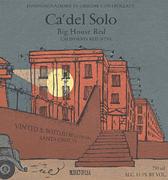Brews: Stones at the Beach
‘In the ever continuing quest by Stone Brewing to appeal to the masses….’ No, scratch that. Hmm, let’s try ‘Stone Brewing's new release destined for trendy appeal….’ Nope. Hardly. OK, how about ‘New brew from Stone Brewing likely to be a hit amongst light beer fans….’ Ouch. Way off base. Nowhere even close.
The real lead-in line should of course read ‘Stone Brewing, experts in pushing the limits of the IPA style, brews up another winner.’ And a winner it is. Patterned after the famous Stone Anniversary IPAs, this new brew is born. Weighing in at massive 100+ IBUs (International Bitterness Units) and 7.7% alc/vol, this baby is a screamer!
”And the name? Stone Ruination IPA. So named, the bottle's label states, ‘because of the immediate ruinous effect on your palate….’ “
The nattering above conveys a taste of the potions (and the marketing) cooked up by Stone Brewing of San Marcos. Ruination was the first new year-round release from the brewer after the introduction of its infamous Arrogant Bastard Ale more than four and a half years before. Stone employs an extreme brewing style that uses natural ingredients – barley, hops, water and yeast – to produce quaffs of strong and distinctive character. Initially, Library Alehouse was attracted by the brewer’s promise of “No Additives, No Chemical Preservatives, No Pasteurization No Adjuncts,” but it is the phenomenal taste that makes us proud to include both beverages in our menu of stellar beers and ales.
 Not a drink for the faint of palate, Arrogant Bastard won’t be a regular or casual choice even among those for whom the hop flower is mother’s milk. This ale pours with a dark caramel color, an unpresumptuous orange-brown head and modest levels of carbonation. The nose is sugary, with a scent of molasses laced with slightly floral and woody notes that causes the sharp aftertaste to come with an element of surprise. The finish is extended, with a sustained bitter attack that prolongs the experience.
Not a drink for the faint of palate, Arrogant Bastard won’t be a regular or casual choice even among those for whom the hop flower is mother’s milk. This ale pours with a dark caramel color, an unpresumptuous orange-brown head and modest levels of carbonation. The nose is sugary, with a scent of molasses laced with slightly floral and woody notes that causes the sharp aftertaste to come with an element of surprise. The finish is extended, with a sustained bitter attack that prolongs the experience. Ruination is intense India Pale informed by an imposing amount of hop bitterness stemming from the application of huge amounts of hops to the brewing and two weeks of dry hopping to the aftermath (dry hopping is a flavor-intensifying technique in which a small quantity of cone hops is added to finished beer before it is shipped). Ruination pours with a clear, dark gold color and an enduring crown of beige-colored foam. Hops dominate the taste, but there is a hint of dry grass and floor-of-the-forest woodsiness to the finish. This ale is imposing, sugary and tart.
Stone’s creations, despite their crisp and breezy qualities, have a moldy rain-forest sourness that persists on the toungue. In a less conformist world, these are tipples of the sort that would be enjoyed in good company with pungent cigars. <http://www.stonebrew.com/>
 There is no escape from this Big House, a thick, fragrant, rustic libation that envelops the palate like honey. Despite its heft, this is a beverage with balance and grace, an elephant poised on one leg, gorgeous crimson in color, redolent of esoteric spices and ripe sugarplums, hints of rosemary and black raspberries persisting from its Piedmontese heritage.
There is no escape from this Big House, a thick, fragrant, rustic libation that envelops the palate like honey. Despite its heft, this is a beverage with balance and grace, an elephant poised on one leg, gorgeous crimson in color, redolent of esoteric spices and ripe sugarplums, hints of rosemary and black raspberries persisting from its Piedmontese heritage.






